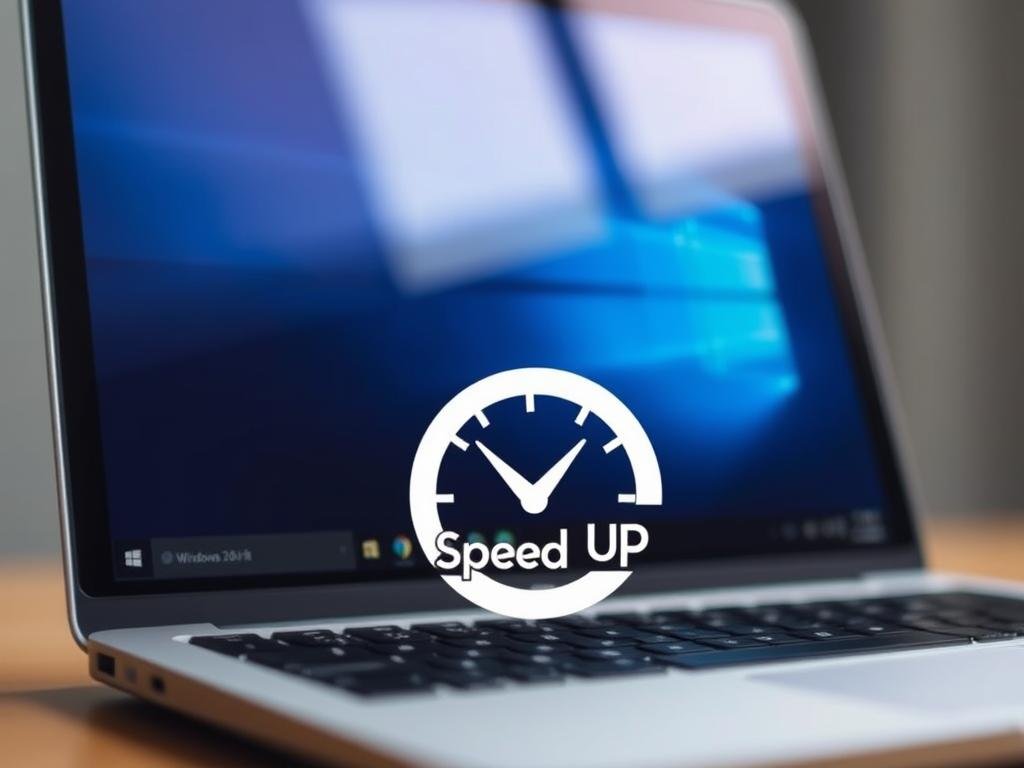Are you tired of a slow computer? You’re not alone. Millions face Windows performance issues every day. This slows them down and adds stress.
But, making your Windows 10/11 faster is easy. With a few simple steps, you can make your computer run smoothly again. This guide will show you how to fix the main problems and get your PC back to speed.
Key Takeaways
- Identify and address common causes of Windows slowness
- Implement DIY optimization techniques to enhance performance
- Utilize built-in tools like Task Manager and Disk Cleanup
- Keep your software and drivers up-to-date for optimal performance
- Consider hardware upgrades for a significant boost
Understanding Windows10/11 Slowness Issues
If your Windows 10 or 11 PC is slow, it’s important to find out why. Slow performance can come from many things. Knowing the main cause is the first step to making your system faster.
Common Symptoms of Slowness
You might see signs that your Windows 10/11 system is getting slower. These signs include:
- Longer boot times
- Slow application launches
- Frequent freezes or crashes
- Sluggish performance when multitasking
Spotting these signs early can help you fix the problem before it gets worse.
Causes of Performance Decline
Many things can make your Windows 10/11 system slower. Common reasons include:
| Cause | Description |
|---|---|
| Overloaded Startup Programs | Too many apps starting up can slow down your PC a lot. |
| Insufficient RAM | Not enough RAM can make your PC slow, when you have many apps open. |
| Malware | Bad software can use up system resources and slow things down. |
For more tips on making your PC faster, check out this resource on PC performance optimization.
Importance of Regular Maintenance
Keeping up with regular maintenance is vital to avoid slowdowns. This includes:
“Regularly updating your operating system and apps, cleaning up disk space, and running disk defragmentation can make your Windows system faster and work better.”
By doing these tasks regularly, you can Improve PC performance and keep your system running smoothly.
Checking System Requirements and Specifications
First, check if your system meets Windows 10/11’s requirements. This is key to fixing slow performance. Your computer’s specs play a big role in its speed and efficiency.
Recommended Specifications for Windows 10/11
Microsoft has set some specs for Windows 10/11 to run smoothly. You’ll need a 64-bit CPU, at least 4GB of RAM (8GB is better), and a compatible processor. For more info on fixing Windows 11 issues, check this guide.
Also, switching to a Solid-State Drive (SSD) boosts performance over Hard Disk Drives (HDD). If you’re using an HDD, consider upgrading to an SSD.
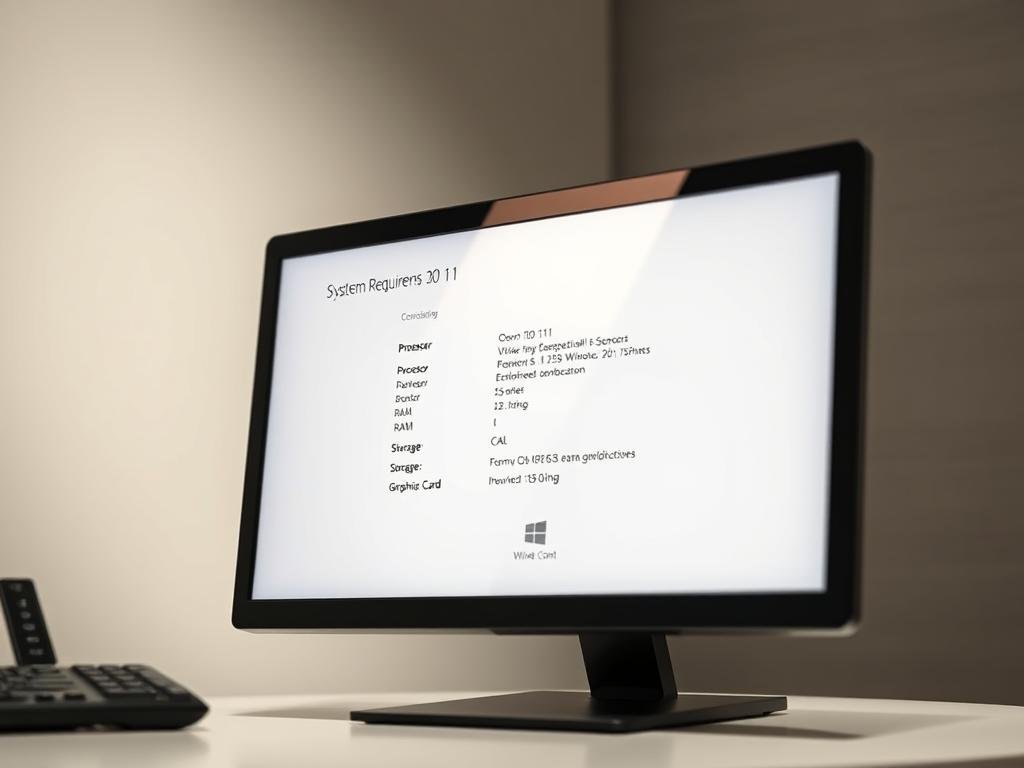
Assessing Your Current Hardware
To see your current hardware, right-click on “This PC” or “My Computer” and choose “Properties.” You’ll find info on your processor, RAM, and system type.
For a deeper look, use the Task Manager (Ctrl + Shift + Esc) to watch your system’s performance. It shows CPU, memory, disk, and network usage in real-time.
Upgrading vs. Optimizing
After checking your hardware, choose whether to upgrade or optimize. Adding more RAM or switching to an SSD can really help. For example, getting an SSD can make your system much faster.
Optimizing your current setup can also improve performance. Close unused programs, disable startup apps, and clean your disk. This can speed up your system without needing new hardware.
Whether to upgrade or optimize depends on your system and needs. If your system is old or weak, an upgrade might be needed. But if it’s fairly new, tweaks might be enough to boost its speed.
Identifying Resource-Heavy Applications
To make your PC run better, you need to find out which apps use a lot of resources. This helps you improve PC performance and speed up Windows 10/11. It’s all about knowing and controlling these apps.
Using Task Manager for Analysis
Task Manager is a great tool for checking what’s running on your PC. To open it, press Ctrl + Shift + Esc or right-click on the taskbar and choose “Task Manager.”
In Task Manager, go to the “Processes” tab. Here, you can see all running apps and background tasks. Sort the list by CPU, memory, or disk usage to find out which apps are using the most resources.
Evaluating Startup Programs
Some apps start automatically when you turn on your computer. This can slow it down. To check startup programs, open Task Manager and go to the “Startup” tab.
In this tab, you can turn off apps that don’t need to start up. Doing this can make your system start faster and work better.
“Managing startup programs is a simple yet effective way to optimize your Windows 10/11 performance.”
Uninstalling Unused Applications
Apps you don’t use take up space and use system resources. To remove unused apps, go to Settings > Apps > Apps & features.
Look through the list of apps you have installed. Uninstall any you don’t use. This will save space and make your system run smoother.
| Application | Disk Space | Resource Usage |
|---|---|---|
| Unused App 1 | 500 MB | High |
| Unused App 2 | 1 GB | Medium |
| Essential App | 200 MB | Low |
By following these steps, you can find and manage apps that use a lot of resources. This will make your PC run better and faster.
Managing Hard Drive Space
One of the simplest ways to optimize your Windows OS is by ensuring you have enough free hard drive space. When your hard drive is nearly full, it can slow down your system. This makes everyday tasks more cumbersome.
Checking Available Storage
To start managing your hard drive space, first know how much storage you have. Go to Settings > System > Storage on your Windows 10/11 device. This will show you how much storage you’re using and how much is free.
Best Practices for Disk Cleanup
Regular disk cleanup is key to keeping your system running well. Here are some best practices:
- Delete temporary files and system files you no longer need.
- Empty the Recycle Bin regularly.
- Consider uninstalling programs you no longer use.
- Use the Disk Cleanup tool to remove unnecessary system files.
Microsoft says, “Regular disk cleanup can help improve your PC’s performance by freeing up disk space.” Doing these tasks regularly keeps your system running smoothly.
“The key to maintaining a fast and efficient computer is regular maintenance, including disk cleanup and management.”
Using Disk Management Tools
Windows has several disk management tools to help you optimize your hard drive space. The Disk Management tool lets you view and manage your computer’s drives. You can format drives, change drive letters, and more.
To access Disk Management, press Windows + R to open the Run dialog. Type diskmgmt.msc and press Enter. From there, you can manage your disks and optimize your storage.
By following these steps and regularly managing your hard drive space, you can enhance your Windows system’s speed and overall performance.
Updating Windows10/11
Updating Windows 10/11 can fix slow speeds and improve performance. It keeps your system safe with the latest security patches and bug fixes. You also get new features that make using your computer better.
Significance of Regular Updates
Regular updates are key to keeping your Windows 10/11 safe and fast. They include:
- Security patches to fight off malware and viruses
- Bug fixes to solve known problems
- Feature enhancements to make your experience better
- Performance boosts to speed up your system
Staying updated greatly lowers the chance of performance and security problems.
Checking for Updates
To see if updates are available, follow these steps:
- Go to Settings > Update & Security
- Click on Windows Update
- Click on Check for updates
If updates are there, Windows will download and install them. You might need to restart your computer to finish the job.
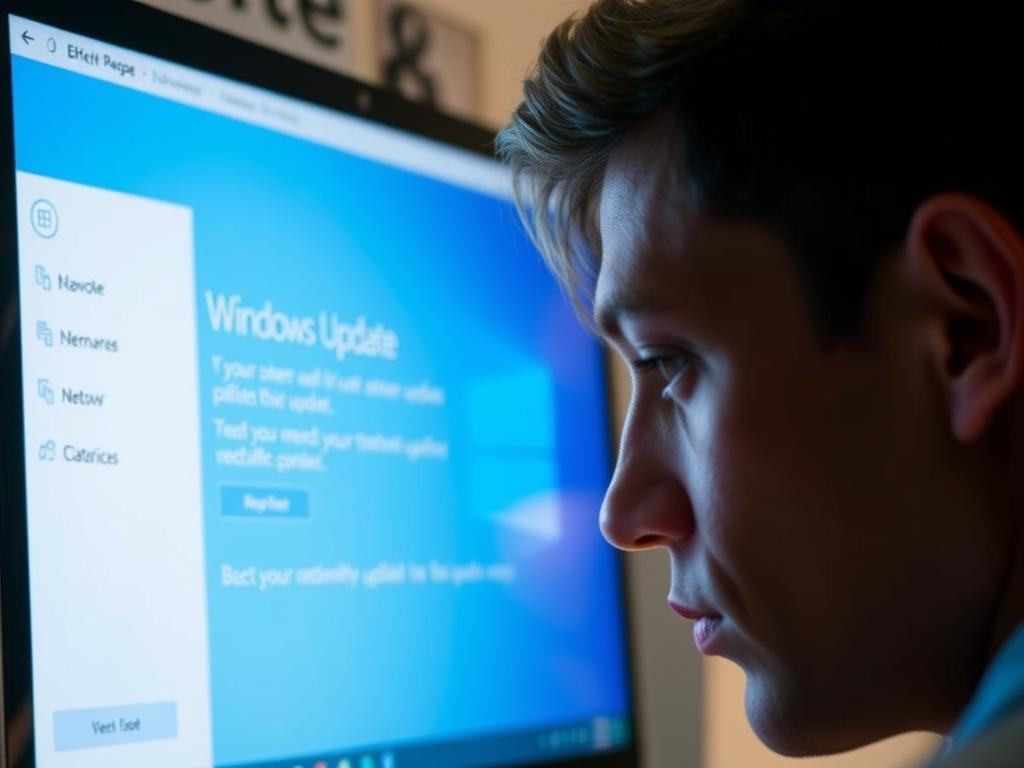
Troubleshooting Update Issues
At times, updating Windows 10/11 can run into problems. Common issues include:
- Failed updates
- Slow update process
- Update installation errors
To fix these issues, you can:
- Run the Windows Update Troubleshooter
- Check for malware with an antivirus program
- Make sure your internet connection is stable
Fixing update problems helps keep your system running smoothly and securely.
Optimizing System Settings
Optimizing system settings can make your Windows 10/11 experience better. By tweaking a few settings, you can improve your PC’s performance and make it run smoothly.
Adjusting Visual Effects
Windows 10/11 has visual effects that can make your experience better. But, they can also use up system resources. Here’s how to adjust these effects:
- Press the Windows key + X and select System.
- Click on Advanced system settings.
- Under Performance, click on Settings.
- Choose “Adjust for best performance” to disable unnecessary visual effects.
Turning off visual effects you don’t need can speed up Windows 10/11. It frees up system resources.
Configuring Power Settings
Your PC’s power settings can affect its performance. To change power settings:
- Go to the Start menu and search for “Power & Sleep settings.”
- Adjust the settings according to your needs, choosing between “Power saver,” “Balanced,” or “High performance.”
For the best performance, set your power plan to “High performance.” But, this might use more energy.
Disabling Background Apps
Some apps run in the background even when you’re not using them. This uses up system resources. To stop these apps:
- Go to Settings > Privacy.
- Select “Background apps” and toggle off the apps you don’t need running in the background.
For more tips on optimizing your PC, check out Dell’s support page on improving Windows 10/11 performance.
| Setting | Description | Impact on Performance |
|---|---|---|
| Visual Effects | Adjusting or disabling visual effects | Improves performance by reducing resource usage |
| Power Settings | Configuring power plans | Enhances performance by optimizing power usage |
| Background Apps | Disabling unnecessary background applications | Frees up system resources for more critical tasks |
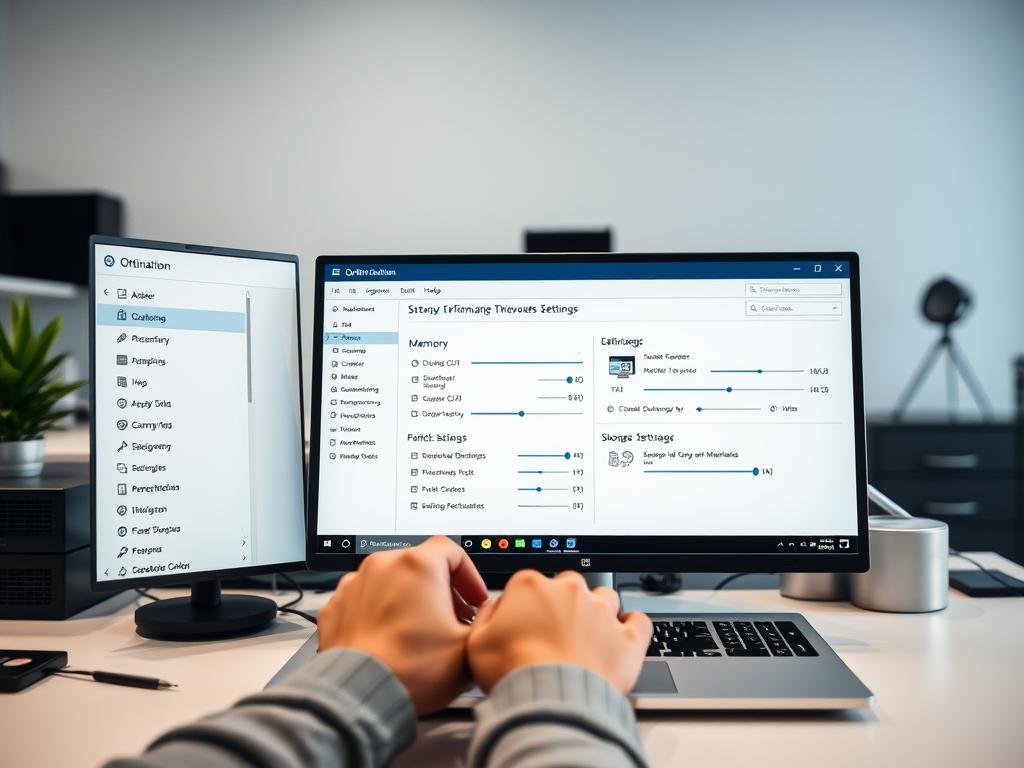
Running System Maintenance Tools
To keep your Windows 10/11 system running smoothly, it’s essential to use the built-in system maintenance tools. These tools help find and fix issues that slow down your computer.
Using Built-In Troubleshooters
Windows 10/11 has troubleshooters that can automatically find and fix many common problems. To access these troubleshooters, go to the Settings app. Then, click on Update & Security and then Troubleshoot. You can choose from various troubleshooters, like those for network connections and audio.
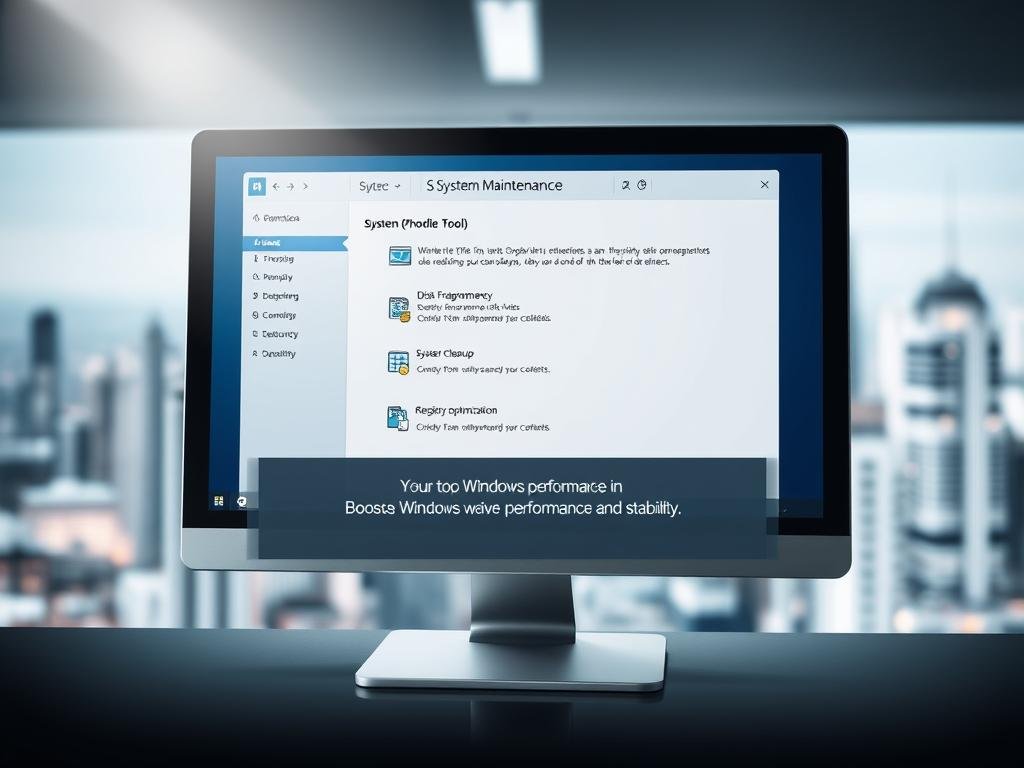
Utilizing Disk Defragmenter
Over time, your hard drive can become fragmented, leading to slower performance. The Disk Defragmenter tool rearranges data on your hard drive, making it more efficient. To use this tool, search for Defragment and Optimize Drives in the Start menu. Open the tool and select the drive you want to optimize.
Running System File Checker
The System File Checker scans and replaces corrupted system files. To run this tool, open Command Prompt as Administrator and type sfc /scannow, then press Enter. This process takes time but ensures your system files are correct and working right.
By regularly using these built-in maintenance tools, you can Troubleshoot Windows 10/11 slow speed issues. This keeps your system running at its best.
Boosting Performance with External Software
Third-party software can offer advanced options for optimizing your Windows system. These tools can give you a more detailed way to boost your PC’s performance.
Recommended Third-Party Optimization Tools
Many trusted third-party optimization tools are out there to help improve your PC’s performance. Some top picks include:
- CCleaner: A well-known tool for cleaning temporary files and boosting system performance.
- Advanced SystemCare: Provides a range of tools for cleaning, optimizing, and protecting your system.
- Razer Cortex: A game booster that also optimizes system performance.
These tools offer various features, like disk cleaning and registry optimization. They help enhance Windows system speed.
Benefits and Risks of Third-Party Software
Third-party optimization software can be very helpful, but it’s important to know the risks. Some benefits are:
- Advanced optimization features not found in Windows by default.
- User-friendly interfaces that make optimization easier.
- The ability to tailor optimization settings to your needs.
But, there are also risks to think about, such as:
- The chance of malware or adware in some free tools.
- System instability if not used right.
- Conflicts with other software installed.
To avoid these risks, it’s key to choose reputable software. Always follow the manufacturer’s instructions carefully.
Upgrading Hardware for Better Performance
If your Windows 10/11 system is slow after software tweaks, it’s time to think about hardware upgrades. Adding new hardware can make your system run faster and more smoothly.
When to Consider Hardware Upgrades
Think about upgrading your hardware if software tweaks don’t solve performance problems. Look out for signs like frequent crashes, slow loading, and general slowness.
Popular Upgrade Options
Some top upgrades for Windows 10/11 include:
- RAM Upgrade: More RAM means better multitasking and faster system response.
- SSD Installation: Switching to an SSD cuts down loading times and boosts performance.
- Graphics Card Upgrade: Upgrading the graphics card is key for high graphics needs.
These upgrades can fix performance bottlenecks and make your system run better.
Installing New Hardware Safely
Installing new hardware requires safety steps to avoid damage. Here are some tips:
- Ground yourself to prevent static electricity damage.
- Follow the manufacturer’s instructions for installation.
- Ensure compatibility between the new hardware and your existing system.
By upgrading wisely, you can speed up Windows 10/11 and enjoy a better computing experience.
Preventive Measures for Long-Term Performance
Keeping your Windows 10/11 system in top shape is key. By being proactive, you can avoid many performance problems later on.
Regular Maintenance Schedules
Keeping your system running well requires regular care. This includes cleaning up disk space, updating software, and scanning for malware. Doing these tasks often helps stop issues before they start.
- Disk Cleanup: Remove temporary files and system files you don’t need.
- Software Updates: Keep your operating system and applications up-to-date.
- Malware Checks: Regularly scan your system for malware and viruses.
Creating Restore Points
System restore points are a safety measure. They let you go back to a previous state if updates or software installs go wrong.
To create a restore point:
- Type “Create a restore point” in the search bar and open the System Properties window.
- Click on “Create” and follow the prompts to create a restore point.
Importance of Antivirus Software
Antivirus software is your first defense against malware and viruses. It keeps your system running fast. Make sure you have good antivirus software and keep it updated.
Comparing different antivirus software can help you choose the best one.
| Antivirus Software | Real-time Protection | System Impact | Price |
|---|---|---|---|
| Norton Antivirus | Yes | Low | $39.99/year |
| Kaspersky Antivirus | Yes | Medium | $59.99/year |
| Avast Antivirus | Yes | Low | Free |
By taking these steps, you can improve your PC’s performance and keep it running smoothly for a long time.
Seeking Professional Help
If you’ve tried to fix Windows10/11 slowness yourself and it didn’t work, it’s time to get help from a pro. Some problems need an expert’s touch to solve.
Expert Intervention
Think about getting an expert if you’re not good at fixing tech problems or if nothing works. They can find and fix issues that are too hard for you.
Cost Considerations
The price for professional help can change a lot. It depends on who you hire, where you are, and what the problem is. Remember, it might cost money, but it could save you time and stress.
Benefits of Professional Assessment
A pro can give you a deep look at why your system is slow. They’ll find the best way to make it fast again. This is great for anyone who uses their computer a lot.
FAQ
What are the common symptoms of Windows10/11 slowness?
Signs include slow startup and delayed responses. You might also see apps running slowly. Sometimes, your system might crash or freeze often.
How can I check if my system meets the recommended specifications for Windows10/11?
Go to Settings > System > About. Look at your processor, RAM, and disk space. Compare them to Windows10/11’s recommended specs.
What is the best way to identify resource-heavy applications on my Windows10/11 system?
Use Task Manager to find apps using a lot of resources. Press Ctrl + Shift + Esc to open it. Sort apps by CPU, memory, or disk usage.
How often should I update Windows10/11 to maintain optimal performance?
Always check for updates and install them as soon as you can. Windows Update will tell you when updates are ready.
Can third-party optimization software improve my Windows10/11 performance?
Yes, some tools can clean up junk files and optimize settings. But, be careful and choose trusted software.
How can I manage hard drive space to prevent slowness?
Check storage by going to Settings > System > Storage. Clean up disk space by deleting unnecessary files. Consider a bigger or faster drive if needed.
What are the benefits of upgrading hardware to improve Windows10/11 performance?
Upgrading, like adding RAM or switching to an SSD, can boost performance. But, think about the cost and make sure it’s compatible first.
How can I prevent Windows10/11 slowness in the long term?
Regular maintenance helps. Schedule disk cleanups, create restore points, and keep antivirus software updated.
When should I seek professional help for Windows10/11 performance issues?
If you’ve tried everything and issues persist, get expert help. They can solve complex problems you can’t handle.
What are the potentially costs involved in seeking professional help for Windows10/11 performance issues?
Costs depend on the service, issue, and repairs needed. Be ready for diagnostic fees, labor, and possible hardware upgrades.
How can I optimize system settings for better performance?
Adjust visual effects and power settings. Disable unnecessary apps. Use the built-in troubleshooter to fix issues.
What is the importance of running system maintenance tools like disk defragmentation and system file checker?
Tools like disk defragmentation and system file checker keep your system healthy. They fix issues like fragmented files and corrupted system files.
